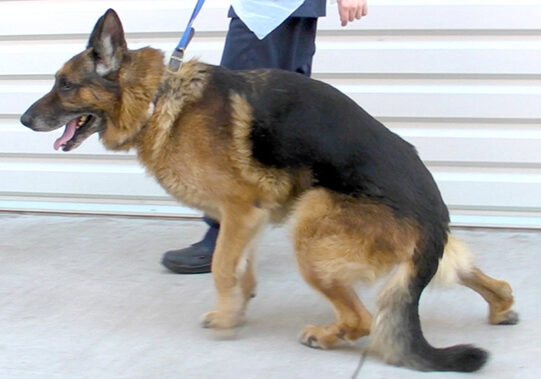Why Should I Bring my Pet to Willows for Degenerative Myelopathy?
Willows is one of Europe’s leading small animal referral centres. Our state-of-the-art hospital is led by internationally renowned Specialists, committed to providing the highest standards of veterinary care. Our Specialist Neurosurgeons are supported by our multi-disciplinary team of Specialists across a number of different disciplines including; Anaesthesia, Diagnostic Imaging and Emergency and Critical Care.
Willows has a large dedicated team of Vets, Nurses and clinical support staff available 24 hours a day, every day of the year to provide the best possible care for your pet. This combination of exceptional facilities and expertise allows Willows to provide the most accurate diagnosis and optimal care for any patient with suspected degenerative myelopathy.
What is Degenerative Myelopathy?
Degenerative myelopathy is a debilitating spinal disorder most commonly seen in German Shepherds, as well the Pembroke Welsh Corgi, Boxer, Rhodesian Ridgeback and Chesapeake Bay Retriever may also be affected. Degenerative myelopathy is a condition that slowly progresses over many months, where nerves within the spinal cord gradually lose their ability to transmit impulses. The nerves in the middle of the back (thoracolumbar spinal cord) tend to be affected initially and from here the degeneration spreads up and down the spine.
What are the Most Common Causes of Degenerative Myelopathy?
The cause of the nerve degeneration is poorly understood, but it appears to be related to an alteration in the genes of the affected dog.

What are the Signs of Degenerative Myelopathy?
The first signs of degenerative myelopathy generally develop at around five years of age. Weakness and loss of co-ordination in one or both of the back legs is often the initial sign, followed by dragging and scuffing of the toes gradually progressing over a number of months. In severe cases the front legs also become affected and dogs can become unable to walk and may develop incontinence. Degenerative myelopathy is not a painful condition and so affected dogs are generally well and keen to exercise, despite their disability.
Fig 1: A German Shepherd Dog with degenerative myelopathy – the hindlimbs are weak and inco-ordinated, and the toes of the right hind paw are being dragged.

How is Degenerative Myelopathy Diagnosed?
The signs of degenerative myelopathy are very similar to many other spinal conditions, such as a ‘slipped disc’ in the back and slow growing tumours of the spine. Investigations are necessary to rule out the many other conditions that can mimic degenerative myelopathy, so that this condition becomes the most likely cause of the neurological dysfunction.
X-rays may be obtained, however they are of limited value as they only show the bones of the spine and not the soft tissues, such as the discs and the spinal cord. A more advanced imaging technique e.g. an MRI scan, is necessary. Myelography is an alternative imaging technique which can be used for investigating spinal conditions. This involves injecting a dye (contrast agent) around the spinal cord and obtaining multiple x-rays to assess the flow of the dye, to see if it is interrupted at the site of the slipped disc. Injecting around the spinal cord is not without risk of causing further damage to already compromised nerve tissue, however MRI is less invasive than myelography with less risk of side-effects, and for most patients MRI provides the best option for investigation. Both MRI and myelography require the dog to have a general anaesthetic. Occasionally it is necessary to collect and analyse fluid that surrounds the spinal cord (cerebrospinal fluid or CSF) in order to rule out inflammatory conditions.
It is possible to establish if a dog has a higher risk of developing degenerative myelopathy by analysing the DNA. This test does not, however, confirm the condition.
What are the Treatments Available for Degenerative Myelopathy?
There is no specific medical treatment for degenerative myelopathy, and surgery is not required as there is no compression on the spinal cord that can be alleviated by an operation. It is important to keep affected dogs as fit as possible and avoid them being overweight. Regular lead walks on soft surfaces, such as grass, and regular hydrotherapy or physiotherapy are often beneficial. In more advanced cases it may be necessary to protect the paws with ‘boots’. Some owners will consider assisting their dog to walk by training them to use a mobility cart; these are commercially available from a number of companies. Dietary supplements, including vitamin E, omega-3-fatty acids, L-carnitine and gamma linolenic acid have all been suggested, however none have been proven to stop or slow the progression of degenerative myelopathy.
What is the Outlook for Dogs with Degenerative Myelopathy?
Degenerative myelopathy is a progressive condition resulting in the affected dog gradually becoming incontinent and losing the ability to walk. This typically takes place over a 12 to 18 month period from the time of onset of signs. Unfortunately on welfare grounds it is often necessary to consider putting severely affected dogs to sleep (humane euthanasia).
To save this page as a PDF, click the button and make sure “Save as PDF” is selected.
Neurology
Find out more
To assist owners in understanding more about Neurological conditions, investigations and treatment we have put together a range of information sheets to talk you through the some of the more common neurological conditions seen by our Specialists.

